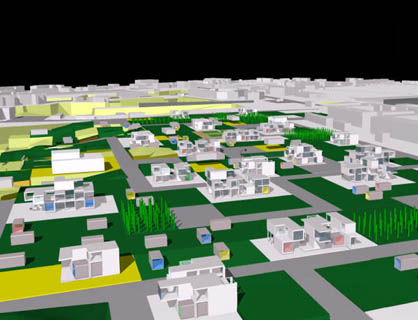|
|
||||
| home | ||||
| D'ANGELO, FALCONE, MASCARUCCI, PINNA. Random City |
||||
| [in
italiano] |
The Random City project was carried out during the travelling seminary of architecture "Villard2". The research was taken out following the competition of
ATER of Pistoia, which dealt with "new ways of living" in the third millennium.
|
[28feb2002] |
||
| The area covered by the project extends behind the railway station in Lecce, in a large open space partly occupied by the old caves of Mario Vito. The fundamental idea of the project was born from the study of a contemporary city, more and more frenetic, in which traditional ways were not able to adapt to these changes. A flexible architecture is therefore a concrete way for resolving the problem. Lecce is a tourist destination where, during the summer months, more than 120.000 people visit. More than half of these tourists stay in campsites. |
||||
 The principal object is giving back to Lecce a "cut-off" space and relating the historic area to a new centrality that doesn't replace it , but wants to be its natural extension. From sometime, tourism in Puglia has becoming the prefered choice for national as well as international visitors. A focus on tourism seems to be the only "industry" in Puglia having a possibility of growth by amplifying and therefore diversifying its resources. |
|
|||
  
|
Random city is a possible response: around the caves a social complex was rebuilt an integrated system of fixed residences (Random Building) and mobile construction (Block house ) : a flexible city where the factor of time determines the way the space is used. Mobile temporary structures (housing blocks, lighting systems, etc..) are equally distributed around the grounds redefining the edges, which are bordered by the caves; the ground is utilizes only if necessary, thereby the green area is returned to its natural state when the buildings are removed. |
|
||
| This isn't a project that requires thousands of tons of cement, but it is a system that will represent true image of the city, enlarging it when necessary. The project will develop in natural harmony with the place. The caves of Marco Vito are the central point of the project: a true model of architecture, in negative sense, because the project (instead of building) leaves a huge open space, which brings together the old city centre, and the new temporary buildings on this site. The caves become an area where contemporary events could be held. The flat ground and the perpendicular wall suggestthat the space could be used for outdoor events such as concerts, theatrical performances and for interim/ transitory happenings. The connection between this system and the historic centre is represented by the new railway station. The plan contains an extension of the pedestrian path in Orazio Quarto Avenue under the railway draw: a kind of square-cross that leads to a small cave (behind the station) which contains services and is also a way through to the new centre. |
|
|||
   RANDOM BUILDING. The stable constructions are used to adjoin the temporary structure. During the summer months and, in general, on request, these units are dislocated from the stable Random Block, creating a more formal setting and occupying the empty ground. The possibility to have a "storage" space nearby allows for easy transportation, resolving any moving problems. |
|
|||
| BLOCK HOUSE. These are the temporary residence units. They come directly from the cyberlab of the French studio Timezone run by architects Claire Petetin and Philippe Gregoire, but their function is radically different. As a matter of fact, the French architects planned and built a new mobile micro laboratory to use it for the inhabitants of the suburbs as a form of "virtual rehabilitation". We equipped this new temporary unit by making it livable in, inside and out,and changing it into a temporary residence. Once it has been used, and is no longer needed, it can be stored, ready for future use. |
|
|||
|
GIANLUIGI D'ANGELO, MATTEO FALCONE, MARIA MASCARUCCI, ANDREA PINNA. Random City Premio speciale al Concorso Internazionale di idee "la felicitą dell'abitare", Ater Pistoia. |
||||

|
Gianluigi D'Angelo,
Matteo Falcone, Maria Mascarucci, Andrea Pinna. Students at the Faculty of Architecture "G. D'Annunzio" (Pescara) They had collective as well as individual experiences by joining seminaries and international planning competitions and collaborating with several planning studios.
Gianluigi D'Angelo (1974)
with Arch+ wins the international prize of Planning "Paesaggi Costieri" Together with Andrea Pinna he manages the digital magazine of architecture
b-e-t-a, mentioned during "Bruno Zevi's" Romarchitettura Prize, second edition. Matteo Falcone with Ca+D'A wins the international competition of Planning Europan6. He has recently worked on the "Paddington Basin" Plan at Richard Rogers Partnership studio in London. Maria Mascarucci collaborated with the ABDR associate architects studio at the Plan for the international competition of Planning concerning the high-speed ? railway in Torino Porta Susa. |
|||
|
>
RANDOM CITY
> CHANNELBETA > ARCHITETTURE |
||||
per partecipare alla rubrica architetture laboratorio
|
||||